Shadow of Tablighi Jamaat controversy looms large over Nizamuddin
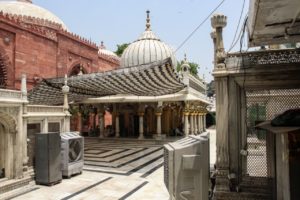
Hazrat Nizamuddin Dargah, a renowned pilgrimage spot, became the principal collateral damage of the Tablighi Jamaat controversy (MIG photos/Aman Kanojiya)
Caught up in a controversy where they had no role to play, residents of the localities around Hazrat Nizamuddin in New Delhi are angry.
Located in the middle of two arterial roads of the capital, the area around Hazrat Nizamuddin in South Delhi is usually crowded, with traffic jams, caused partially by the thousands of pilgrims, coming from across the country in dozens of buses, who visit the famous Dargah (tomb) of Nizamuddin Aulia, a 13th century Sufi saint, one of the most popular in this part of the world.
A typical evening in the locality would be defined by the smell of delicious Mughlai dishes being cooked in the numerous small restaurants in the area as well as the chants of qawwalis with sufi music wafting over the air here, not to mention crowds of residents and visitors jostling each other to move ahead in the narrow lanes, that somehow never slept.
However, for nearly 95 days now, the lanes and by-lanes of the Nizamuddin area have been deserted, bereft of people, traffic, music and cuisine. Even though just 50 metres from here, the main road is beginning to experience traffic jams again as most of the residents of Delhi start to go back to work, the lanes around the Dargah are still sealed off to any traffic. And a posse of armed policemen is stationed next to a barricade which has been placed there to ensure that no vehicles enter the area.
On the day that your correspondent visited Nizamuddin, there was hardly any activity, with not a person in sight, even though nearly everything else all over Delhi has reopened and crowds are slowly building up, though yet nowhere near the levels that prevailed before the pandemic struck. After a while, two women, with their faces covered by scarves, emerge on the lane. Walking briskly past the policemen who watch them casually, the women barely stop to talk. But in very few words, they sum up the mood and the spirit of the entire area. ‘‘We have been defamed, plain and simple. Not a single case of coronavirus has been reported from the area where we live, yet the media painted a picture that this was a laboratory where the virus was created and that we are out to infect the entire country. We know how we have passed the past three months, living inside an area that was completely sealed off and even now, the movement is highly restricted. The government did nothing to help us or to even clear the air about the controversy,’’ says the younger of the two women, before they resume walking.
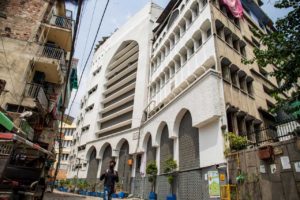
Tablighi Jamaat’s offices, a few minutes’ walk from the Dargah, have been sealed since late March, following the controversy over the gathering earlier that month
The controversy they refer to had erupted in late March and continued to dominate the national media in India for several weeks. It involves a meeting of Tablighi Jamaat, an Islamic missionary organisation, that has its headquarters, Markaz, at a stone’s throw from the Dargah.
The government claimed that of the 4,400 Covid-19 positive cases in India at the end of March, nearly a third were related to the religious meeting at the Markaz which had gathered over 8,000 people, including foreigners.
Barely had the news broken that hashtags like #CoronaJihad began trending on Twitter, with many leaders of the ruling Bharatiya Janata Party (BJP) calling the religious gathering a case of ‘corona terrorism’. According to a report in Time magazine, tweets with #CoronaJihad appeared nearly 300,000 times and were potentially seen by 165 million people. A central minister called the Markaz gathering a ‘Talibani crime’.
The hatred towards the entire Muslim community in India spread faster than the virus. There were reports from all over the country where people stopped buying vegetables from Muslim vendors. Tenants were asked to empty the houses based on their religion. And very soon, Tablighi Jamaat and Markaz Mosque had become synonymous with Nizamuddin – the Dargah and the locality.
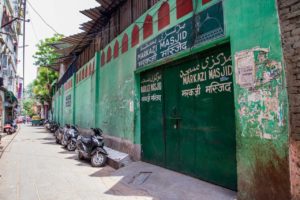
Markazi Mosque, also in the same locality, remains locked over three months on, even as police probes the management over their role in the gathering
And three months later, even as there are traffic jams in other parts of Delhi, the lanes of Nizamuddin are silent as the grave. The only way people commute here are either on foot or the e-rickshaws. There is disappointment on the face of people, who think that they were community shamed and publicly humiliated by this misinformed and vested political campaign of hate and vilification after the Tablighi Jamaat case.
They feel that the both the government and media failed them during a moment of crisis. Indeed, some of them accuse the media of launching a witch hunt against the entire area even though the Tablighi Jamaat meeting took place well before the lockdown was announced and when all religious places were open and thronged by devotees all over the country. ‘‘However, somehow only this area became the focus of the media and a government investigation and we have been blamed, without evidence, for the spread of coronavirus in the country,’’ says Tahir Shaikh, who sells trinkets and small household items in the area.
The officials of the Dargah say that they have kept the holy site closed and will not reopen unless the government tells them to open, adding that the health of people was primary. At first, they try to dismiss the controversy saying that the Dargah and Markaz have nothing to do with each other and deny that there has been any defamation of the holy site. However, after slight probing, they open up and blame the media for confusing the Tablighi Jamaat with the Dargah. They go on to accuse the media of running a vested campaign and politicians trying to score political points by vilifying the entire locality.
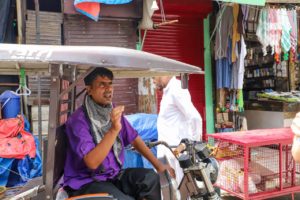
Residents, who had no role in the gathering, have paid unduly heavy price due to the controversy and the area remaining sealed, says Mohammad Ghayasuddin Khan, a shopkeeper who took to driving e-rickshaw to make a living
But not everyone in the area is as sanguine about it. Mohammad Ghayasuddin Khan, originally from Bihar, has been living in Nizamuddin for 30 years. He ran a shop selling dates but as the shop was closed during the lockdown, he was forced to drive an e-rickshaw to earn a livelihood and feed his family of five. ‘‘Earlier, I used to make about INR 2,500 a day, but now I am managing with only INR 400. How do you expect my family expenses to be run in this? I have to pay for tuition for my children and have the usual household expenses to take care of. The media have simply created a witch hunt for which we are paying the price as the entire area has been sealed off since March even though there are no cases of coronavirus patients here. But as you can see, the police are everywhere and movement of people is practically zero,’’ he says.
Nazir Khan runs a cycle rickshaw and is more vocal about the damage caused by the controversy to the poor. ‘‘The government and the media can say what they want to, but at the end of the day each person has to take care of his hunger and his family. No one is feeding me here, I have to manage on my own,’’ he says. So strictly was the lockdown enforced here that even some of the pharmacies remained closed and opened only recently.
Iqhlakh Hussain runs a buffalo meat shop in the area that had also remained shut till end of last week. But even though he reopened earlier this week, the footfall of customers is very thin and as a result, he is barely able to sell 20-25 kg a day and if someday the meat remains, he distributes in the community. Reticent about how he managed while the shop was shut, he just points his hands upwards to say Allah took care of him. The shop has been around for over 50 years and has a regular clientele from the neighbourhood, he says.
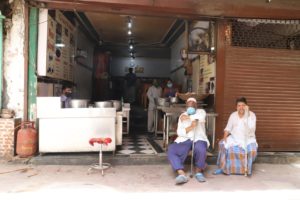
Chiraguddin Qureshi says that of the 20 employees that he had, only five have remained as the rest fled to their villages early on during the lockdown, customers are few even now
To cater to the thousands of devotees who visited the Dargah daily, there are several restaurants in the area serving a variety of Mughlai cuisine. New Qureshi Hotel is one such eatery. Chiraguddin Qureshi, who inherited it from his father, says that the restaurant had 20 full time employees and received over 500 customers daily in the pre-pandemic period. Having remained closed till late last week, the restaurant now hardly receives any customers. Qureshi says that most of his employees had gone back to their villages and only about five remained, to whom he has paid full salaries despite the lockdown. ‘‘Yes, I have incurred losses, but I must pay them as these losses mean nothing and the ultimate profit and loss account is registered in Allah’s books only,’’ he says. Most restaurateurs hope that the Dargah would be opened soon but add that people would remain cautious until they feel safe and only then they will start visiting in big numbers again.









